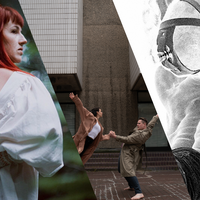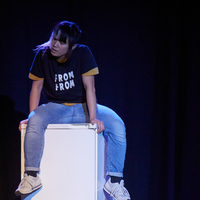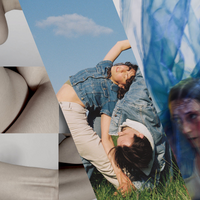Thu 25 Jan: Chiara Martina Halter, Kitty Pilgrim-Morris and Chaldon Williams

News Story
Chiara Martina Halter33 RPM
Kitty Pilgrim-MorrisThe Agony of Definition
Chaldon WilliamsAwakening
33 RPM’s confrontational nature is anticipated, but unsettling nonetheless, given its focus on the cost-of-living crisis and exacerbation of socio-economic segregation. Accompanied by the reverberating of crashing waves, we meet two women who undulate across the floor as though victim to an external force, uncontrolled by themselves. As a beeping treadmill and a piercing operatic voice are introduced, the theme of absent autonomy remains constant. Both dancers perform with a certain lack of emotion, as if void of agency, and yet, we sense an underlying (though futile) hint of rebellion. Although the idea of competing individuals is not particularly conveyed, Chiara Martina Halter succeeds in beautifully illustrating a familiar struggle and the relentless everyday slog we know only too well.
Kitty Pilgrim-Morris is mesmerisingly animated in The Agony of Definition. What begins as a comedic piece, receiving regular laughs from the audience, soon turns dark, desperate, and pitifully frenzied. In an exuberant fashion, a character performs a series of movements, before loudly exclaiming, “this is the same place you found me last time!”. They subsequently appear to lose their way; their memory seemingly abandoning them. Not quite masking their increasing distress at their failing, they paint on a clown-like smile and begin again. As their attempts multiply and their hysteria intensifies, a gradual discomfort washes over the watcher, as we come to realise that this Sisyphean task is unlikely to avail. The piece closes on a note of relief, as soothing music and a warm light fill the space, perhaps suggesting the character has arrived at acceptance. Intelligent and surreal, The Agony of Definition is enthralling.
Chaldon Williams’s Awakening is an enjoyable and refreshing work, based on Hip-Hop styles. The choreography showcases intricate isolations and dynamic musicality, with the dancers manipulating their own movements, as well one another’s, and on occasion, appearing to manipulate gravity too. Whilst there is no doubting the skill of the cast and I appreciate the individual style that each dancer possesses and applies to the movement, the communication of any intended narrative or themes is indistinct. A repeated diamond-shaped hand gesture hints at power and influence, but increasingly palpable motifs feel missing. Though visually interesting, Awakening lacks perceptible meaning which, for me, would make the piece more engaging.
Emma van Boolen
Choreographer Chiara Martina Halter and Alessia Tomassi Marinangeli appear dramatically in disarrayed baroque- style costumes against the back wall. A running machine and gramophone sit ominously downstage as symbols of control? Suddenly the women flop to the ground in exhaustion. From there they morph into tightly executed floor rolls and falls, mirroring each other’s thrashing movements before transitioning into walking sequences, both on and off the running machine. The women seem to want to tell us a story, but I’m not clear what it is. There's definitely struggle and hardship suggested through the interplay of moody lighting, angst-ridden actions, smoke, and the harsh, scratchy record playing operatic singing. Some evocative ingredients suggest suffering and the pair’s lack of autonomy but they remain as loose, disconnected ideas making 33 RPM feel undercooked.
In contrast Kitty Pilgrim-Morris knows what they’re all about. Or rather as a performer they do, emitting a strong sense of self, articulated through theatrical expressivity and varied, competently performed technique. Pilgrim-Morris’s fictional character Claybourne, however, is lost in a sea of words, writing and time. A hanging installation of notes fluttering in the breeze conveys Claybourne’s attempts at remembering where they are or what day it is: “Here I am” or “Back again”. What works so well in this tragicomedy are repeated movement sequences that become increasingly more manic and desperate. Pilgrim-Morris effortlessly segues between narrative, dance and functional action, riveting in this sophisticated work that squeezes a little too much into a Resolution slot.
The third work of the evening, Chaldon Williams’Awakening, brings both spiritual and visual relief as it describes a meditative journey from (black, male) strife to enlightenment, communicated through Hip-Hop theatre. Four male dancers amass around the calm, regal energy of Korinthia Hockell. She’s an intriguing presence as the only woman, pursuing her own path with fluid, weaving gestures, quietly holding power at the centre of this confluence of restless male energy. Dynamically contrasting movement builds on popping, gestures and vibey sound that feels grounded and sincere. This promising group of artists should have more confidence in the rich language they elicit from the Hip-Hop form, performed with heartfelt commitment.
Josephine Leask


